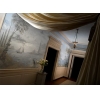|
 Venetian
Plaster is the finishing technique when thin layers of plaster are applied with
a spatula or trowel and then the smooth surface is created on the base of
illusion of depth and texture. Venetian
plaster is American-made term for the variety of different techniques and
materials used to create the polished stucco finish. Venetian Plaster tells
about its glamorous look of polished marble and natural stone to the design of
your interior. The lavish and smooth finish is layered with the double-tone
appearance of marble surfaces bringing the visual attention and charm. Natural
marble is exceptional in Italy,
however, it is the material for prosperous people to afford and, thus, the
local craftsmen would aspire to create amazing less valuable of higher
usability, and finally they came to the Venetian plasterwork. Venetian
Plaster is the finishing technique when thin layers of plaster are applied with
a spatula or trowel and then the smooth surface is created on the base of
illusion of depth and texture. Venetian
plaster is American-made term for the variety of different techniques and
materials used to create the polished stucco finish. Venetian Plaster tells
about its glamorous look of polished marble and natural stone to the design of
your interior. The lavish and smooth finish is layered with the double-tone
appearance of marble surfaces bringing the visual attention and charm. Natural
marble is exceptional in Italy,
however, it is the material for prosperous people to afford and, thus, the
local craftsmen would aspire to create amazing less valuable of higher
usability, and finally they came to the Venetian plasterwork.
The Venetian plasterwork is far more expressive and looks
lively than the marble in nature. It can look tender as the watercolor, glossy,
opaque, be incredibly rich and be presented as the genuine paintings.
The warmer touch
of Venetian Plaster is ideal for the casual, contemporary or traditional
interior styles. The more layers are applied, the more depth and polish
you achieve. The Venetian masters put the price higher than affordable for such
a work, though. The coating
has the special feature when it is not visual in picture, for the authentic
beauty and silky appearance are lost, as well as the suppleness and depth of
the Venetian plaster of high quality. By the way, the date of the
Venetian plasterwork origin is not known clearly, though the masters of the
Renaissance period widely practiced coating a la marble to decorate houses of
the wealthy. The Venetian plaster
was neglected for some period for its extremely high price, though currently it
is practiced again as the elite coating due to progress in industry.
Today it is hard to imagine that juice of berries or animal
blood is used as the coloring agent in Venetian plaster. Nevertheless, the
other components of the plaster are still the same, including the marble
powder, crushed granite, slaked lime, juice of rubber-bearing plants and water.
And here the Venetian plaster is still ecologically friendly, smell-free, anti-wear
coating, firesafe, dries quickly and it is easily washed off for some kinds of plaster.
The wax the walls coated with commits in the feature for washing off. The wax
is applied as the final finish when the synthetic kinds of wax add some opaque
surface and are easily washed and thus they are ideal for premises of high
humidity while the natural wax brings the deep gloss though not all of them are
water-proof.
The major condition when applying the Venetian plaster on
the surface is the even walls, whether from gypsum plasterboard, wood or
concrete. The even and grounded wall is the first and significant detail to
start plastering. It is better when your walls are done by professionals and
you can think of the texture and color of your walls thanks to a variety of
coloration agents, which are offered in abundance. On one part, you can invite your acquaintance
who happened to be the specialist in plastering which is not the best way here.
The poorly done plasterwork looks ugly and dull and far more appropriate
variant is the professional plasterer with recommendations from any construction
company or the designer of interior who can, in addition, help in choosing the
right hue or even apply some patterns.
The Venetian plasterwork is costly to be afforded by
ordinary people since it is complicated and labor-consuming activity, leaving
apart patterns over it. Though, there are rare people who can paint in marble. One
of companies concerned in this sphere is Crete which uses the Venetian plaster
by the Italian Company Viero. This plaster is known to be free of lame as the
component which adds the high elasticity and opportunity to paint on walls.
Anyway, even if you fail to décor the walls with the
Venetian plasterwork, it is worth considering a small part of the wall to be
decorated in such an exclusive and beautiful material.
|